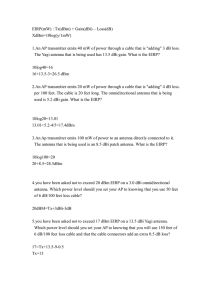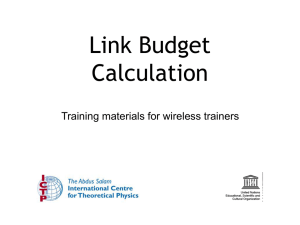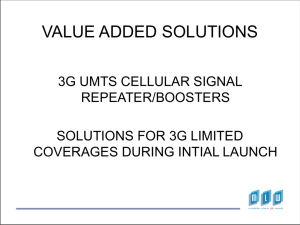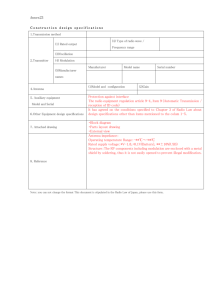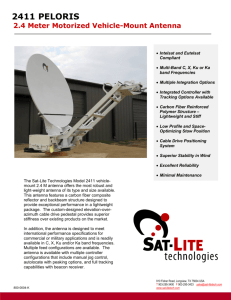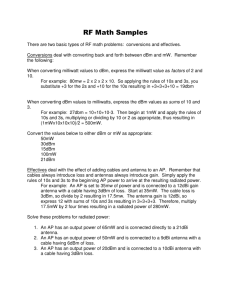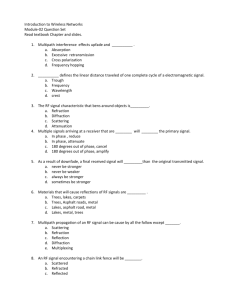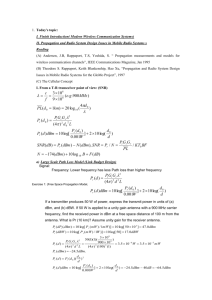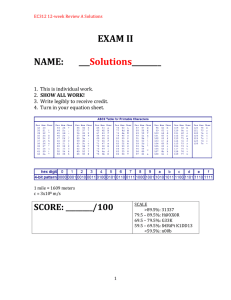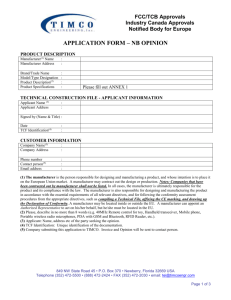Faculty of Computer Science & Engineering Chapter 02. Radio
advertisement
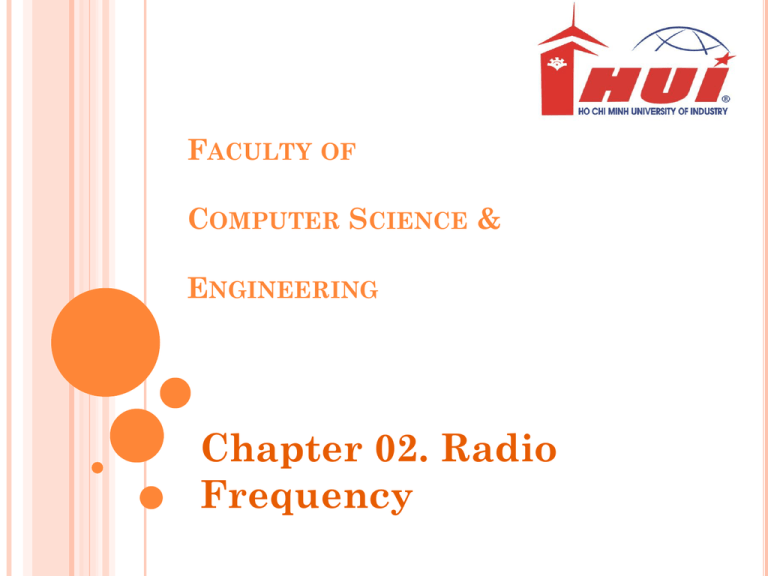
FACULTY OF COMPUTER SCIENCE & ENGINEERING Chapter 02. Radio Frequency QUESTION 1 1. When visual line of sight (LOS) is present, RF LOS will always be present. A. This statement is always true B. This statement is always false C. It depends on the configuration of the antennas QUESTION 2 2. When RF LOS is present, visual LOS will always be present. A. This statement is always true B. This statement is always false C. It depends on the specific factors QUESTION 3 3. What unit of measurement is used to quantify the power gain or loss of an RF signal? Choose all that apply. A. dBi B. dBm C. Watts D. dB QUESTION 4 4. Using which of the following will reduce VSWR? Choose all that apply. A. Cables and connectors that all have an impedance of 50 Ohms B. Cables with a 50 Ohm impedance and connectors with 75 Ohm impedance C. Cables and connectors that all have an impedance of 75 Ohms D. Cables with 75 Ohm impedance and connectors with 50 Ohm impedance QUESTION 5 5. In an RF circuit, what is the intentional radiator defined as? A. The output of the transmitting device B. The output of the last connector before the signal enters the antenna C. The output as measured at the antenna element D. The output after the first length of cable attached to the transmitting device QUESTION 6 6. dBi is a relative measurement of decibels to which one of the following? A. Internet B. Intentional radiator C. Isotropic radiator D. Isotropic radio QUESTION 7 7. Which one of the following is considered impedance in an RF circuit? A. The inability to transmit RF signals B. Interference of an RF signal during foul weather C. Resistance to current flow, measured in Ohms D. The frequency on which an RF transmitter sends signals QUESTION 8 8. In RF mathematics, 1 watt equals what measurement of dBm? A. 1 B. 3 C. 10 D. 30 E. 100 QUESTION 9 9. Which one of the following RF behaviors is defined as “the bending of a wave as it passes through a medium of different density”? A. Diffraction B. Reflection C. Refraction D. Distraction QUESTION 10 10. Given an access point with 100 mW of output power connected through a 50-foot cable with 3 dB of loss to an antenna with 10 dBi of gain, what is the EIRP at the antenna in mW? A. 100 mW B. 250 mW C. 500 mW D. 1 W QUESTION 11 11. Given a wireless bridge with 200 mW of output power connected through a 100 foot cable with 6 dB of loss to an antenna with 9 dBi of gain, what is the EIRP at the antenna in dBm? A. 20 dBm B. 26 dBm C. 30 dBm D. 36 dBm QUESTION 12 12. Given an access point with an output power of 100 mW connected through a cable with a loss of 2 dB to antenna with a gain of 11 dBi, what is the EIRP in mW? A. 200 mW B. 400 mW C. 800 mW D. 1 W QUESTION 13 13. Given an access point with an output power of 20 dBm connected through a cable with a loss of 6 dB to an amplifier with a 10 dB gain, then through a cable with 3 dB of loss to an antenna with 6 dBi of gain, what is the EIRP in dBm? A. 18 dBm B. 23 dBm C. 25 dBm D. 27 dBm QUESTION 14 14. What is the net gain or loss of a circuit if it is using two cables with 3 dB loss each, one amplifier with a 12 dB gain, 1 antenna with 9 dBi gain, and an attenuator with a loss of 5 dB? A. 5 dB B. 10 dB C. 15 dB D. 20 dB QUESTION 15 15. Which of the following is a cause of VSWR? A. Mismatched impedances between wireless LAN connectors B. Too much power being radiated from the antenna element C. The incorrect type of antenna used to transmit a signal D. Use of the incorrect RF frequency band QUESTION 16 16. Radio waves propagate (move) away from the source (the antenna) in what manner? A. In a straight line in all directions at once within the vertical and horizontal beamwidths B. In circles spiraling away from the antenna C. In spherical, concentric circles within the horizontal beamwidth D. Up and down across the area of coverage QUESTION 17 17. Why is the Fresnel Zone important to the integrity of the RF link? A. The Fresnel Zone defines the area of coverage in a typical RF coverage cell B. The Fresnel Zone must always be 100% clear of any and all blockage for a wireless LAN to operate properly C. The Fresnel Zone defines an area around the LOS that can introduce RF signal interference if blocked D. The Fresnel Zone does not change with the length of the RF link QUESTION 18 18. The FCC allows how many watts of power to be radiated from an antenna in a point to multipoint wireless LAN connection using unlicensed 2.4 GHz spread spectrum equipment? A. 1 watt B. 2 watts C. 3 watts D. 4 watts QUESTION 19 19. In regards to gain and loss measurements in wireless LANs, the statement that gains and losses are additive is: A. Always true B. Always false C. Sometimes true D. Sometimes false E. It depends on the equipment manufacturer The END

